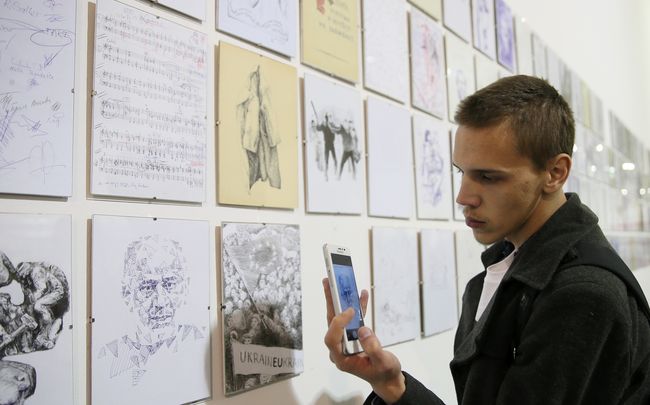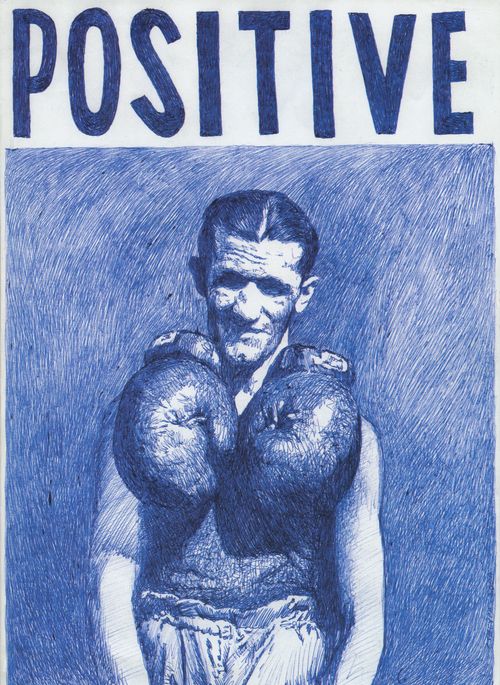A4 paper sheet and ballpoint pen
Yevhen KARAS: “We want to explore modern life with simplest tools”
Karas Gallery, located in Andriivsky uzviz, is one of the oldest ones in Kyiv. It has a rich experience of expositions and cooperation with leading Ukrainian artists.
The projects include a quite remarkable many-year portfolio project “A4, ballpoint pen.” It has existed since 2006. The essence and concept of the project is the creation of art with everyday means, without using any traditional artistic media. The exhibits open close to New Year’s Day.
The Day talked to the initiator of the project and all-time director of the galley Yevhen KARAS about the A4 project.
How did the project begin?
“In 2006 (almost 10 years ago) Mykola Kryvenko suggested organizing an exhibit ‘Artists draw on paper.’ Painting was prevailing at the artistic stage of that time, but we wanted to bring up the genre of drawing, which was not considered as an independent one, rather as some sort of sketching. We were thinking on how to crystallize this genre, uniting the authors by one format. It turned out that another artist, Vinni Reunov, had a ready project on paper of A4 size. We decided to do it this way: a ballpoint pen, office A4 paper sheets, vertical composition. The pilot exhibit was a success, and we arranged a new one the following year. We did not expect that the artists would take interest in it again. However, to our joy, there were even more works. It is gratifying for us that on the 10th year ‘Ballpoint pen’ has reached a level, when there are so many professional high-quality drawings, as well as interested participants. We have accumulated over 3,500 works: this is the largest collection of pen drawings in the world. The space of the gallery and Ukraine became too small for the project. We brought it to Art-Vilnius, showed at Art-Kyiv, and at the Book Arsenal, and we have big international plans.”
Have you inquired how popular this technique is?
“In the West there are communities of ballpoint pen artists. They mostly draw pop stars and politicians in the only style – hyperrealism, i.e., copy a photographic resemblance of life; they are not involved in this as full-fledged art. The largest exhibit took place in America and involved 15 artists who showed about 60 works. We exhibit works of up to 200 authors on an annual basis, with our last exhibit displaying 400 drawings with absolutely all styles represented: abstraction, conceptualism, pop-art, surrealism, mail-art, art-brute, naive, chanson-art, same hyperrealism, etc.”
How does all of this function?
“There is one division, the invited participants, i.e., the artists with whom we have been cooperating for a long time, and the second one is a competition program, where anyone can submit their works, from children to professionals, which however does not lower the demands to quality. We select 300-400 works out of several thousands of pictures that people bring or send to every exhibit. The main restrictions include vertical composition on usual office paper and monochromic (blue, black, violet) ballpoint pen, not a gel one. However, if an artist whom we love a lot, offers horizontal works drawn in colored pens or on old yellowed paper – we step back from the rules, but the exception makes not more than 5-10 percent. This project is comfortable because when different styles are present next to one another on the wall, no controversy arises. There is a powerful intellectual density per square meter. At the same time, ‘Ballpoint pen’ can be shown both at a biennale, and in a kindergarten. Conditionally speaking, it is meant both for intellectuals and taxi drivers, because the main message is creating art through primitive means.”

What do you mean?
“The audience feels distracted when it sees the picture in a gallery or museum, usually: the artist is in a better position, because s/he operates a huge number of specialized materials and instruments, which are not available for ordinary audience. In this case, the artist steps down from the Olympus, takes everyday things – a ballpoint pen (often disliked by artists) and office paper, and it turns out that art is not technology, but something that lies in a totally different plane. The audience understands that an unrealized artist lives in every person or s/he may already be an artist, because he has a pen, but he lacks faith in himself or something else, which s/he may find at the exhibit.”
Is the exhibit limited only to drawing?
“We collect the music sheets of composers, in particular, such famous ones as Valentyn Sylvestrov, Oleksandr Shchetynsky, Sviatoslav Luniov, Viktoria Poliova, and insert them in the artistic context, and sometimes a different, metaphysical aesthetics of the score can be decoded. We involve litterateurs, such as Zabuzhko, Neborak, Zhadan, who also give us their manuscripts. For example, Zabuzhko presented a text of preparation for a meeting with readers; someone writes a poem on a sheet of paper. The aesthetics is not present at the beginning, but we want to bring it out of music or literary text through handwriting, logic, and internal beauty of combination of letters and notes in the process of shaping of a work in another, not pictorial genre. For us it is very important to get aesthetics from any textual information. Every person with a pen is a participant of the project, his notes and writings are works of art. We want to explore modern life with simplest tools.”
Are you going to develop the project?
“There are different ideas. To suggest the artists to illustrate some famous cult book, like The Little Prince by Saint-Exupery. To accumulate the illustrations every year and then compile a separate publication. Or to take an issue of a well-known international art magazine, like Art News or Art in America, disassemble it, give to artists for ‘mockery,’ and then republish it, to have a kind of Ukrainian intervention into the world art as a result. The project with its mass and dynamics exceeds the frameworks of the gallery, and our colleagues help us bring it into the international context. Every year we publish albums with a pressrun of 2,000 copies and they are sold out. In such a way, we have an audience of several tens thousands of people, and we want to bring this number to a million. Many different routes are opened.”
Have you thought of creating a museum?
“We will have to do this, when we have 10,000 drawings. I do not know in what form it will be. But I think that we must have such a museum.”
However, for this you need to prosper here and now. So, my last question is not about art. Not so long ago there were raiders’ attacks on the galleries of Andriivsky uzviz, including yours. What is the current state of affairs?
“The situation is not original: the society has changed, but the power hasn’t. Yet we managed to repel the attack. After 10 years of trials, we have finally returned a part of the gallery into communal property. Competent people can imagine how much money and strength it has taken. Maybe this is the only precedent at Andriivsky uzviz, when civic activists returned real estate property to the city. But it has never been simple in this business and it will never be. We spend 60 percent of our efforts not for art, but for signing lease agreements, repairs, and communal problems. Although we get tired, we still manage to do something interesting from time to time – artists, theoretician, colleagues, audience, and friends, to whom we are very thankful, together for 25 years now – in the gallery and other venues.”
Newspaper output №:
№30, (2015)Section
Culture





